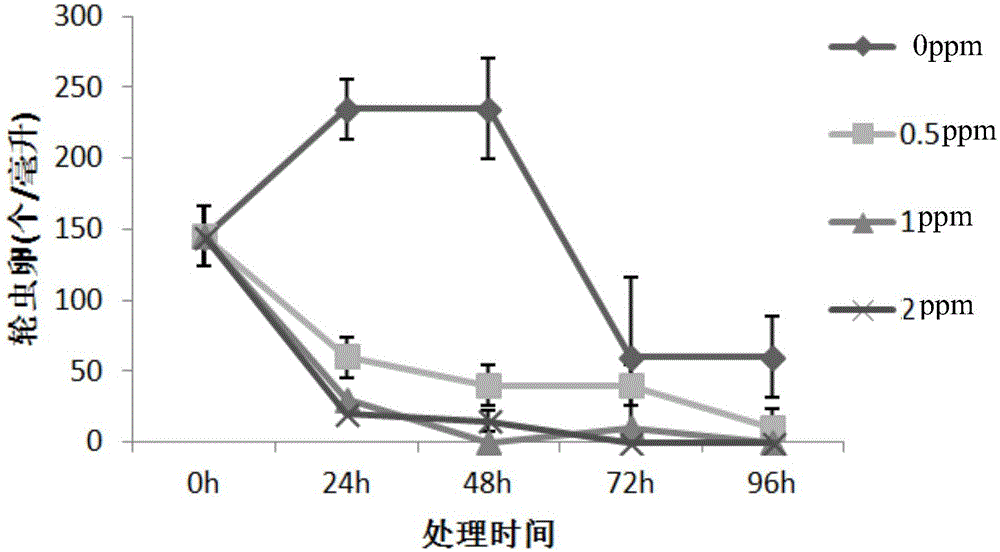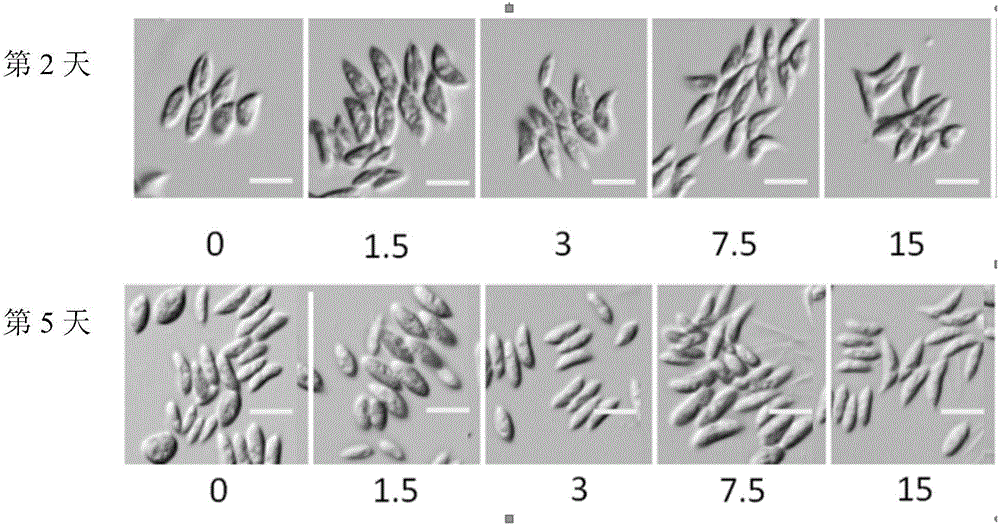Application of rotenone in inhibition of rotifer spawning
A technology of rotenone and rotifers, applied in the field of pest control in microalgae cultivation, can solve the problems of respiratory system obstruction, slow movement, paralysis, etc., and achieve the effect of reducing the application concentration and reducing the impact
- Summary
- Abstract
- Description
- Claims
- Application Information
AI Technical Summary
Problems solved by technology
Method used
Image
Examples
Embodiment 1
[0026] Embodiment 1: the impact experiment of low concentration rotenone on rotifer adults and rotifer ovum
[0027] Rotifer contamination was found in the 12L plate reactor culture. On the third day after the discovery of rotifers (the oviposition rate reached ≥ 50%, indicating that the rotifers will lay eggs in large quantities), take 100ml of culture solution into 12 250ml Erlenmeyer flasks respectively. , randomly divided into 4 groups, each with 3 repetitions. Each experimental group was added different concentrations of rotenone, respectively 0ppm, 0.5ppm, 1ppm and 2ppm, at 20°C room temperature, 45μmol photons m -2 ·s -1 Cultured with shaking under light conditions. Take 2ml samples from each Erlenmeyer flask every 24h, fix with 1% Lugol's iodine solution, count the number of rotifers and rotifer eggs with 100μL zooplankton counting box under an inverted microscope (Olympus, model BX41) , and each sample was counted in triplicate.
[0028] The result is as figure 1...
Embodiment 2
[0029] Example 2: Effect experiment of the use of rotenone on the growth of Scenedesmus
[0030] Effect of rotenone on Scenedesmus growth experiment: Scenedesmus was cultured in a 1L column reactor, and the experiment was divided into 5 groups, with 3 repetitions in each group. Each reactor was initially inoculated with the same amount of Scenedesmus, with a dry weight of 0.8 g per liter, the medium is BG-11. Each group was added with rotenone, and its effective concentration was controlled to be 0, 1.5, 3, 7.5, and 15 ppm respectively. At room temperature of 20℃, 165μmol photons m -2 ·s -1 Under the conditions of light and aeration, CO 2 The amount is 2%. Sampling 20ml in each column reactor every 24h, observing the state of Scenedesmus living cells under a microscope (Olympus, model BX53) and taking pictures for comparison (such as image 3). Take 10ml and filter it with a dry GF / C membrane, measure the daily dry weight of Scenedesmus, and the growth state of Scenedesm...
Embodiment 3
[0032] Rotifer pollution was found in the process of cultivating Scenedesmus in a 12L flat plate reactor. The culture conditions were 20℃, 165μmol photons m -2 ·s -1 Under the conditions of light and aeration, CO 2 The amount is 2%, and the medium is BG-11. On the third day of continuous observation under the microscope, it was found under the microscope that the oviposition rate of rotifers was ≥ 50%, and rotenone was immediately added to a concentration of 0.5 ppm. After 24 hours, the reduction rate of rotifer ovum was 74.5%, and after 96 hours, the natural reduction rate of rotifer adults reached 37.0%, but most of the rotifers were shrunken (such as Figure 5 ), the feeding movement is reduced, and there is no danger to microalgae at this time. Compared with the 48-hour LC50 recorded in literature as 2.89ppm (Agbon, 2004), the amount of rotenone used in this example is reduced by 82.7%, which can achieve a considerable control effect.
PUM
 Login to View More
Login to View More Abstract
Description
Claims
Application Information
 Login to View More
Login to View More - R&D
- Intellectual Property
- Life Sciences
- Materials
- Tech Scout
- Unparalleled Data Quality
- Higher Quality Content
- 60% Fewer Hallucinations
Browse by: Latest US Patents, China's latest patents, Technical Efficacy Thesaurus, Application Domain, Technology Topic, Popular Technical Reports.
© 2025 PatSnap. All rights reserved.Legal|Privacy policy|Modern Slavery Act Transparency Statement|Sitemap|About US| Contact US: help@patsnap.com



